Image of the Day Archives
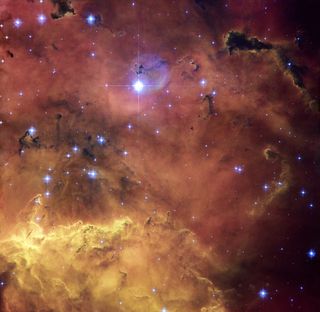
For older Image of the Day pictures, please visit the Image of the Day archives. Pictured: NGC 2467.
Made in America

Monday, Sept. 2, 2013: Happy Labor Day from SPACE.com. A Delta 4 Heavy rocket launched a secret satellite for the National Reconnaissance Office (NRO) from Vandenburg Air Force Base in California on Aug. 28, 2013. The NROL-65 mission supports national defense. The Delta 4 Heavy, built by ULA and first flown in 2004, represents the biggest, most powerful American rocket in operation today. The 235-foot-tall (72-meter) launcher produces about 2 million pounds of thrust at liftoff, according to ULA officials. Two strap-on boosters give the rocket a distinctive appearance.
— Tom Chao
Back-to-School Geography Quiz: What Feature Is This?
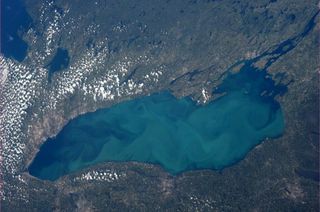
Tuesday, Sept. 3, 2013: It’s again that time of year when you head back to school, students! Here’s a quick quiz for you: Astronaut Karen Nyberg tweeted this photo of the Earth taken from the International Space Station on Aug. 25, 2013. Who knows what this geographical feature is? Hint: It’s a body of water. Answer tomorrow.
— Tom Chao
Like a Star Exploding in the Night
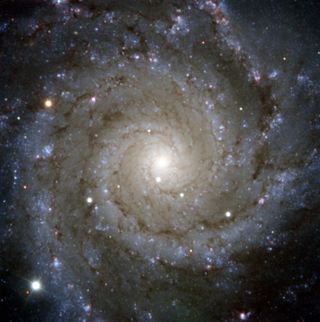
Wednesday, Sept. 4, 2013: Messier 74, a spiral galaxy with well-defined whirling arms, seems stunning enough. However, this image contains another amazing sight: a Type II supernova named SN2013ej, visible as the brightest star at the bottom left of the image. SN2013ej represents the third supernova spotted in Messier 74 since the turn of the millennium, the other two being SN 2002ap and SN 2003gd. The latest supernova was first reported on July 25, 2013 by the KAIT telescope team in California. Amateur astronomer Christina Feliciano took the first "precovery image," using the public access SLOOH Space Camera to peer at the region in the days and hours immediately before the explosion.
— Tom Chao
[Answer to yesterday’s Back-to-School Geography Quiz: Lake Ontario.]
New Stars Are Born

Thursday, Sept. 5, 2013: ESA’s Herschel space observatory sees the Orion A star-formation cloud in this image. The Orion Nebula lies within the central bright region of this scene, where massive star formation occurs most intensely. Cooler gas and dust glows in red and yellow, with point-like sources representing the seeds of new stars.
— Tom Chao
In the Still of the Night
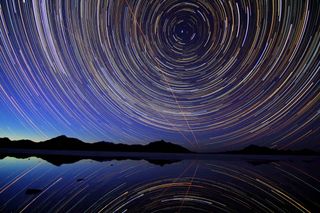
Friday, Sept. 6, 2013: Astrophotographer Jerry Payne sent in a photo of star trails reflected in water covering the Bonneville Salt Flats near Wendover, Nevada. Payne writes in an e-mail to SPACE.com: “The photo consists of a about 2 hours worth of 30-second exposures summed using Startrails.exe software ... This area of the salt flats was covered with a thin layer of water, from either snow-melt or a recent storm. That plus a cloudless night, no moon, and extremely calm wind conditions allowed for this photo.” Photo submitted September 3, 2013.
— Tom Chao
Pump It Up
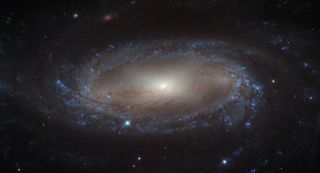
Monday, Sept. 9, 2013: Spiral galaxy IC 2560 lies over 110 million light-years away from Earth in the constellation of Antlia (The Air Pump). It represents a relatively nearby spiral galaxy, making up part of the Antlia cluster — a group of over 200 galaxies held together by gravity. This cluster unusually appears to have no dominant galaxy in it. Astronomers call this spiral a Seyfert-2 galaxy, a kind of spiral galaxy characterised by an extremely bright nucleus. The bright center of the galaxy may be caused by the ejection of huge amounts of super-hot gas from the region around a central black hole. The unusual name of the constellation traces back to French astronomer Abbé Nicolas Louis de Lacaille, who named originally named Antlia, “antlia pneumatica,” in honor of the invention of the air pump in the 17th century.
— Tom Chao
Get the Space.com Newsletter
Breaking space news, the latest updates on rocket launches, skywatching events and more!
Arc of a Curve

Tuesday, Sept. 10, 2013: Saturn's rings appear to arc over the planet in this image from the Cassini spacecraft. Cassini spacecraft took the image with its wide-angle camera on June 15, 2013, using a spectral filter sensitive to wavelengths of near-infrared light centered at 705 nanometers. Cassini acquired the view at a distance of approximately 657,000 miles (1.1 million kilometers) from Saturn.
— Tom Chao
In the Belly of the Whale
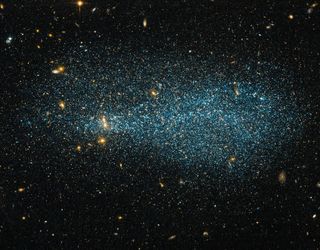
Wednesday, Sept. 11, 2013: Dwarf galaxy ESO 540-31 lies just over 11 million light-years from Earth, in the constellation of Cetus (The Whale). Many other galaxies fill the background of this image, and they lie at vast distances from Earth. Dwarf galaxies represent some of the the smaller and dimmer members of the galactic family, typically only containing around a few hundred million stars. This number pales in comparison to spiral galaxies like our Milky Way, which contain hundreds of billions of stars. Image released Sept. 9, 2013.
— Tom Chao
Magnetic Fields
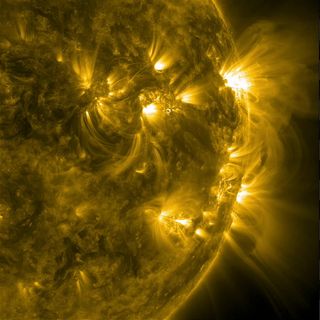
Thursday, Sept. 12, 2013: This photo taken by the Solar Dynamics Observatory (SDO) shows magnetic field lines emerging from several active regions on the sun, Sept. 4-5, 2013. The easily observable lines reached from one magnetic pole to another. Extreme ultraviolet light reveals tracings of charged particles along the magnetic field lines. The bright, active regions represent areas of intense magnetic forces. SDO provides imaging with a level of detail previously unavailable.
— Tom Chao
Whose Fault Is It?
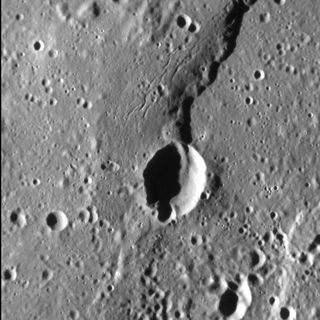
Friday, Sept. 13, 2013: This MESSENGER spacecraft image of planet Mercury shows a landform known as a lobate scarp, the nearly vertical ridge at the top center of the image. Scientists believe these scarps form when one block of crust thrusts up and over another, in response to the global contraction of Mercury as its core cooled and solidified. These scarps frequently cross-cut impact craters of all sizes. However, this particular scarp represents one of only very few scarps that display thin, linear depressions on their upper surfaces. Possibly these features are graben — fault-bounded troughs that form when rock is extended — like those seen in Caloris basin (a large impact crater on Mercury). If true, then these graben are among the only such structures known to occur outside of volcanically flooded impact basins and craters.
— Tom Chao
Join our Space Forums to keep talking space on the latest missions, night sky and more! And if you have a news tip, correction or comment, let us know at: community@space.com.

